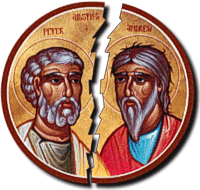The Archbishop of Canterbury has called on Anglicans to ‘disagree well’ in the debates that divide Anglicans. However a recent survey indicates that so far from disagreeing well, the majority of male Anglican evangelical clergy believe that separation is a better option than tolerating disagreements in the Communion. They would also prefer that agreement would somehow be insisted on by a central authority. Their support for such a (papal?) pronouncement would, of course, depend on it conforming to their pre-existing convictions.
It is important to unpack what is being said on both sides in this debate. The Archbishop with his elegant phrase, ‘disagree well’, captures a gracious ability to live with people who do not agree with you or who use a different set of concepts and language to talk about God or moral issues. The ability to allow for a different narrative about such things alongside your own, is not difficult for the inclusive Christian. They will have a strong awareness that their own position is never the last word. The liberal inclusive thinker will also recognise, as this blog has emphasised many times, that words themselves are sometimes unhelpful in the task of describing truth.
The contrasting position, which has been revealed in a recent Yougov poll organised by the Westminster Faith Debates, reveals that two thirds (68%) of male evangelical clergy have no sympathy with the idea that the Anglican Church as a whole should embrace diverse ideas. A smaller number (61%) of evangelical women clergy would also take this line. For both groups, the idea of propositional truth trumps any idea of the possibility of ‘disagreeing well’ with those who do not follow the ‘correct’ line, whether it be on moral issues or on doctrine. From this perspective, truth, as presented in doctrinal statements or in the words of Scripture, cannot be changed or compromised. God’s will has been revealed in words and any attempt to change these words and propositions will be firmly resisted.
Overall the Yougov poll shows that most clergy approached support Archbishop Welby with his call for the church to ‘disagree well.’ 75% would back this appeal. But the problem of a fixed determined intransigence among a certain proportion of the clergy seems to be not easily resolved. As I have said recently on this blog, the reason for this failure to agree or to tolerate difference is unlikely to be completely theological but rather to tap into other aspects of personality and psychology. This blog continues to explore what these non-theological factors might be. But whether this intransigence comes from an individual psychology or a tribal mentality, it continues to be an institutional nightmare for our leaders in the church. The days of absolute episcopal power seem to be over as lay people, who pay for the church, begin to flex their institutional muscles. These same lay people will listen, not to a remote bishop, but to the clergyman at hand. If he defies the local bishop, then they will support him, when necessary, by withholding the Parish Share. A financial famine is the one thing that could cause the whole Anglican structure to collapse. It appears to be quite close in certain Dioceses in the North of England and in the Diocese of Truro.
The ability to ‘disagree well’ is something that I, as the editor of this blog, can firmly endorse. The problem is, however, not what I, as an individual, think but whether the church as a whole allows its intransigent minority to become more and more dominant. This year, according to the poll, those who cannot and will not shift from a fixed position numbers 25%. In five years time, what will that total be? This blog has its aim the desire to suggest that the tsunami of conservative thinking in the church should be challenged and if possible checked. Resisting intransigent thinking, even in a very tiny way, is a worthy activity, not only because it stands up for truth of a generous and inclusive kind, but also because truth of this type is less likely to cause pain and suffering to those who encounter it. Truth and compassion are two very good reasons for welcoming the Archbishop’s call on all of us to ‘disagree well’.
